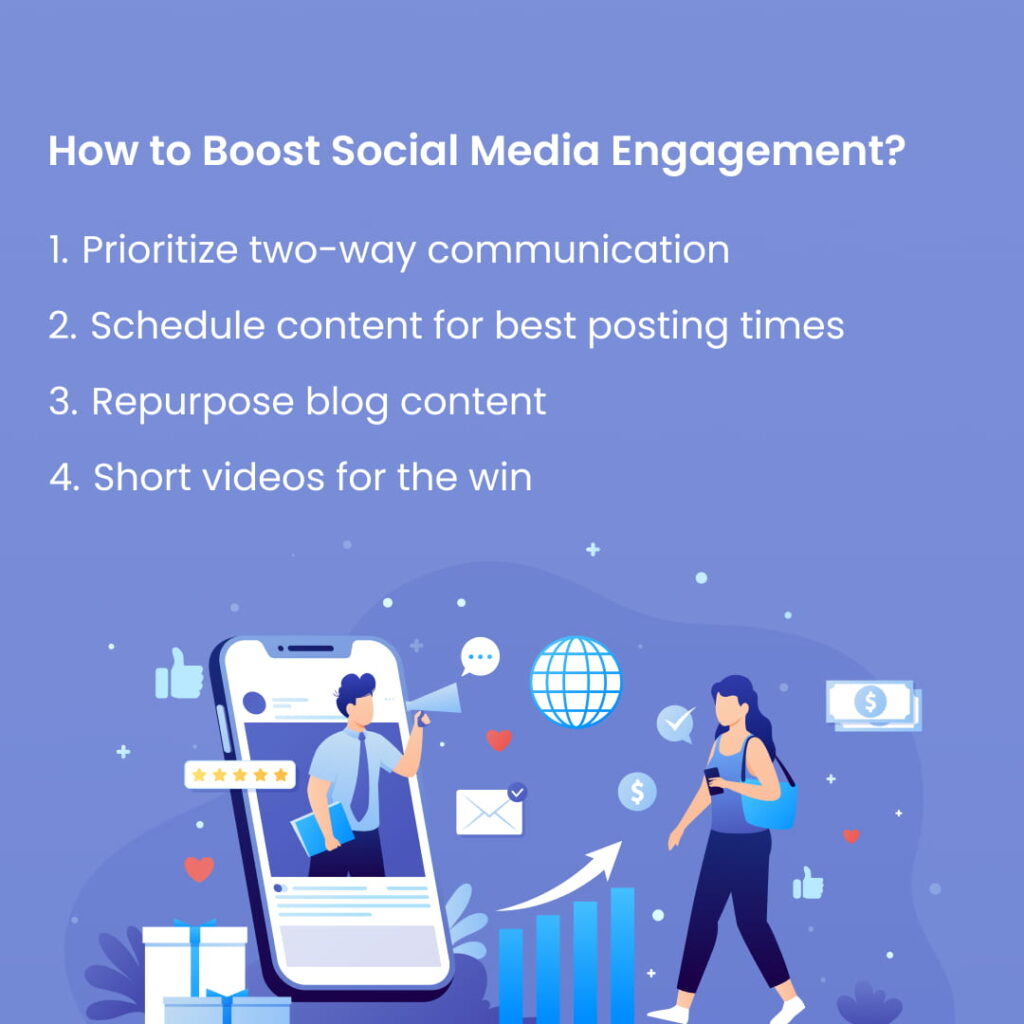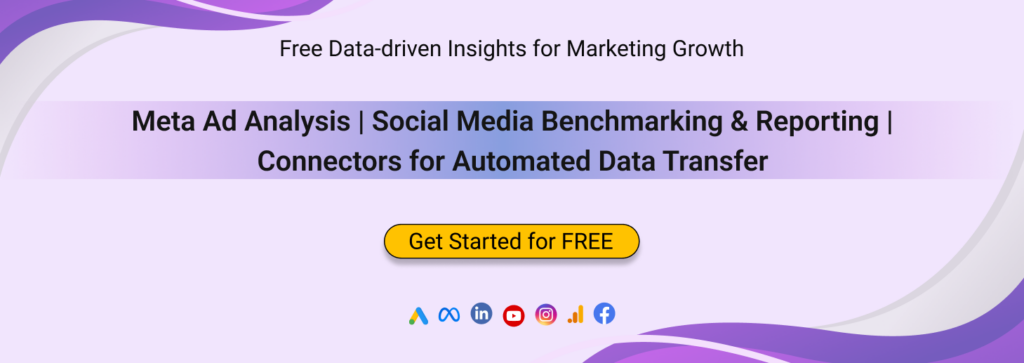Back in the 2000s, social media felt new and exciting.
Today, it’s like a crowded marketplace where everyone wants to sell you something. (PS: Did you know the that social networking penetration rate in the US is greater than 91%?)
With this level of saturation, marketers like you and me need to prioritize social media engagement over anything else.
If you’re also wondering how to increase engagement on social media or how to measure social media engagement — all while initiating real conversations — this blog is for you!
Let’s get started.
Social media engagement refers to how well people are interacting with your content on various social media platforms. It includes actions like likes, comments, shares, saves, and even clicks. These interactions show that your audience finds your content interesting or valuable.
So basically, engagement can cover anything and everything that showcases a user’s interest in your content.
For example:
These are some of the common social media metrics that will help you calculate the engagement rate for your accounts.
Technically speaking, social media engagement does not depend on (or tell) about the quality of interactions. However, that’s not entirely true!
High-quality engagement will definitely mean more for your social media strategy efforts than a high number of passive interactions.
The first stage of social media engagement process is awareness. This is when your audience notices your content for the first time.
It could be through a catchy post, a trending hashtag, or even a recommendation from a friend. Creating attention-grabbing content is key to making a strong first impression.
Social media engagement is the reflection of your brand’s ability to hold a user’s attention. The higher the engagement, the better you’re able to resonate with your target audience.
But it’s just not about seeing the numbers spike up on the dashboard! More engagement can also boost your organic visibility on social media platforms.
And here’s a (not-so-secret) secret for you: Social media algorithms can be your best friend — as long as your content is receiving engagement from users. With organic reach declining rapidly, your content needs to grab attention and force the user to take action to interact with it.
In a nutshell, social media engagement is how you win in this overcrowded landscape.
Following the mantra of “keep your users engaged” is easier said than done.
But these pointers should help you keep the notification bell ringing.

You can’t get social media right unless you’re focusing on the “social” part. Simply posting content and then going dark is where you might be missing the chance to connect with your audience.
Utilize the comment section well to make the other person feel valued. Your prompt response will also help you add extra information to the conversation, thus taking a step towards conversion.
It’s like painting yourself as a human, rather than an automated chatbot.
For two-way communication, you can also create social media communities. Here’s how to create a Facebook group for your brand.
Don’t simply post whenever the mood strikes! (That’s when your posts get lost in a sea of content without reaching the feeds of your followers or target consumers.)
Find a timeframe of when your followers are most active and schedule your content to be posted in that hour.
To make the best use of golden posting hours, try out Vaizle’s free best time to post on Instagram, best time to post on Facebook, and best time to post on LinkedIn tools.

If you’re doing well in terms of SEO, chances are you already have an active blog section on your website.
Long-form content uploaded there won’t perform well on social media, but what if you repurposed it to create intriguing posts for different platforms?
In a way, it’s like killing two birds with one stone. Not only can you increase engagement, but also bring more traffic to your website.
Not yet hopped on the video marketing bandwagon? That’s another reason why your social media content might be getting ignored.
If we’re to believe the latest statistics, 95% of digital marketers say that video marketing helps them increase brand awareness.
Creating short-form videos for social media can be the missing piece to your social media marketing puzzle.
You can measure social media engagement in 3 ways:
The first step of measuring social media engagement manually is defining the objectives and selecting relevant KPIs.
Based on that, you can go ahead and manually calculate the engagement rate.
Engagement Rate formula = (Total Engagement / Total Followers) x 100
Here, total engagement will be the sum of all key metrics selected to measure your social media impact. For example: if you’re focusing on brand awareness, you will have to take reach and impressions into consideration.
Every social media platform gives users access to an analytics dashboard to help them understand the pattern of content performance and audience engagement.
You can check Facebook Insights, Instagram Insights, or Twitter Analytics to know more about the latest social media metrics like likes, comments, profile visits, shares, etc.
Native analytics is good — as long as you don’t have to manage multiple social media accounts at once.
Then, it becomes hectic to switch between different tabs and bring all relevant insights into a consolidated dashboard.
That’s where Vaizle comes into use!
Vaizle is a one-stop marketing analytics suite that can help you track social media engagement for various accounts simultaneously. Additionally, you get:

Try out Vaizle’s range of free digital marketing analytics tools and get started now!

Churning out interactive posts for various social media platforms — day in and out — has got to be hectic!
And if you’re not careful enough, creative block is only a few steps away from taking away your social media marketing motivation.
To ensure consistency in posting, here are a few ideas to add to your content calendar:
User-generated content can be a great way to showcase authenticity. Encourage your existing and new customers to share their honest feedback and reviews and then repost them on your official account.
Check how Apple has successfully tapped into the UGC zone!
It is hard to scroll past a good meme. And if it’s relatable enough, it is really hard to resist sharing it with your friends. (Win-win situation, right?)
Here’s Netflix US making the best use of memes, like always.
Brand partnerships can help you get in front of an audience that you might not reach on your own. Doing so can also help you build cross-promotional relationships with industry leaders.
Read more: How to use Instagram Collab Posts in Social Media?
By creating educational content, you are establishing yourself as an industry leader and giving users a chance to follow you for more such information.
Also, this gives you a chance to use relevant keywords and boost your website’s SEO.
Interested in more trending ideas? You’d also like:
What’s the biggest challenge you face while using social media to grow your business?
If social media engagement has been a constant worry for you too (we’ve all been there!), I hope this guide helps overcome the roadblock and brings forward a fresh perspective.
And if you feel the need for a social media or ad analyst, Vaizle can be your next best buddy. Gain access to the exclusive marketing analytics suite for 7 days — only at $1.
Meanwhile, don’t forget to sign up for the Vaizle newsletter to get such actionable recommendations in your inbox.
A social media engagement tool is a platform that can easily manage large volumes of notifications and DMs, while allowing you to interact from the same dashboard.
Using this tool allows you to stay on top of all messages and comments, and promptly solve user complaints or queries.
Posting on social media won’t have any positive consequences for your business unless your audience is engaged.
Posting without gaining any engagement would be similar to delivering a lecture to an empty classroom. (You can’t expect any two-way interaction and positive results.)
Social media engagement theory is the understanding of user behavior that dictates their social media usage. According to this theory, more engagement implies more social media usage. As such, if a user is engaging with your account, they are likely to come back for more content.
Engagement of social media followers is crucial because it implies users are taking an active interest in your brand. Here, number of followers can also be a vanity metric because it doesn’t ensure a spike in sales, lead generation, or ROI.
The first stage of the social media engagement process is awareness. At this stage, you want more people to notice your account and then eventually engage with the content.
Mamta is an SEO Analyst with 3 years of experience. Currently, she is spending her time on content roadmapping to drive organic growth and engagement for SaaS businesses. Mamta is also an avid cinephile who spends her spare time watching latest action and sci-fi flicks from around the world.
Copyright @VAIZLE 2025